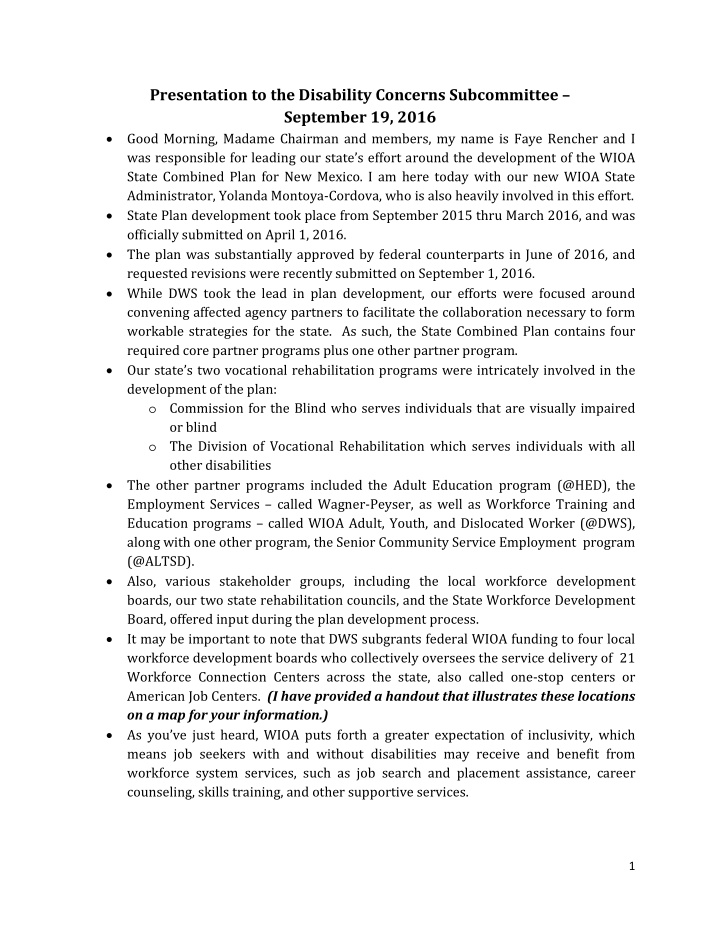



Presentation to the Disability Concerns Subcommittee – September 19, 2016 • Good Morning, Madame Chairman and members, my name is Faye Rencher and I was responsible for leading our state’s effort around the development of the WIOA State Combined Plan for New Mexico. I am here today with our new WIOA State Administrator, Yolanda Montoya-Cordova, who is also heavily involved in this effort. • State Plan development took place from September 2015 thru March 2016, and was officially submitted on April 1, 2016. • The plan was substantially approved by federal counterparts in June of 2016, and requested revisions were recently submitted on September 1, 2016. • While DWS took the lead in plan development, our efforts were focused around convening affected agency partners to facilitate the collaboration necessary to form workable strategies for the state. As such, the State Combined Plan contains four required core partner programs plus one other partner program. • Our state’s two vocational rehabilitation programs were intricately involved in the development of the plan: o Commission for the Blind who serves individuals that are visually impaired or blind o The Division of Vocational Rehabilitation which serves individuals with all other disabilities • The other partner programs included the Adult Education program (@HED), the Employment Services – called Wagner-Peyser, as well as Workforce Training and Education programs – called WIOA Adult, Youth, and Dislocated Worker (@DWS), along with one other program, the Senior Community Service Employment program (@ALTSD). • Also, various stakeholder groups, including the local workforce development boards, our two state rehabilitation councils, and the State Workforce Development Board, offered input during the plan development process. • It may be important to note that DWS subgrants federal WIOA funding to four local workforce development boards who collectively oversees the service delivery of 21 Workforce Connection Centers across the state, also called one-stop centers or American Job Centers. (I have provided a handout that illustrates these locations on a map for your information.) • As you’ve just heard, WIOA puts forth a greater expectation of inclusivity, which means job seekers with and without disabilities may receive and benefit from workforce system services, such as job search and placement assistance, career counseling, skills training, and other supportive services. 1
• As such the state plan incorporates the disability population within its four key overarching strategies. (As a part of the state plan, the VR programs have program- specific sections that include more detailed strategies.) • I’ll highlight the strategies that speak most directly to services for individuals with disabilities. o Increase coordination efforts between employment & training activities and partner programs to improve the quality of participants’ experiences & interactions with the workforce system. o In an effort to govern the core programs as one system, this strategy emphasizes the need for the core partners to come together to mutually assess the strategic needs of each program and identify areas where service strategies can be aligned. o This strategy is particularly critical as it relates to activities carried out in the local area for target populations, such as individuals with disabilities. o Specifically, the strategy involves: reassessing the one-stop delivery system and what is needed to achieve seamless service delivery models that put the customer first; supporting universal accessibility to services and products for all customers. formalizing points of contact within partner programs to provide for more seamless referral processes and more robust follow-up activities to ensure positive outcomes of participants referred to other partner programs; improving the ability of staff in the workforce centers to assist all individuals, including individuals with disabilities and other individuals with barriers by providing coordinated technical assistance and staff training and development; and identifying and coordinating outreach efforts to shared customers as well as to businesses for job development. o Emphasize work-based experiences for target populations. o WIOA places a keen emphasis on work-based experiences across target groups, particularly youth, individuals with barriers to employment, and individuals with disabilities, as a means to prepare for, obtain, maintain, advance in, or reenter competitive employment. o WIOA also provides enhanced access and flexibility for work-based training options for these populations, such as: Registered Apprenticeship; On-the-job training (OJT); 2
Customized training and incumbent worker training; and Internships. • The other two strategies in the state plan involve: o Emphasizing broader participation in career pathways and sector strategies; and o Strengthening workforce development and education linkages. • The next step in WIOA implementation planning include: o Working with the local workforce boards on the development of their Local WIOA Plans, and we have developed guidelines to help guide them in that process. o The local plan development timeline will run from October 2016 to March 2017. • Examples of the programmatic changes we will be looking for within local planning that impact the disability population include: o efforts to survey and evaluate the Workforce Connection Centers for physical and programmatic accessibility; o robust referral processes; o approach to the cross-training of program staff; o improvements around customer-centered case management and service delivery; o approaches to joint outreach and business development efforts; o efforts around data management for tracking participation and outcomes against WIOA performance expectations; and o local board membership that reflects representation from all state plan partner programs, as these boards will play a key and ongoing role in ensuring the effective implementation of WIOA requirements. • Anyone can access the most current draft of the State Plan on DWS’ website. (I have provided a handout that tells you where to find the documents.) • That concludes my remarks and my colleague, Yolanda, and I are happy to answer any questions you may have. 3
Recommend
More recommend